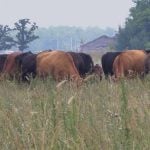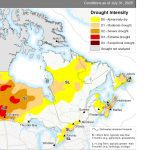Doug Emsley has some advice for investors contemplating a 30 percent decline in their stock portfolios since September – put your money in farmland.
“With the market coming down around everybody’s ears, this is a very stable asset class,” he said.
“Arguably it is an even better hedge against turbulent times than gold is.”
Of course he has a vested interest in saying that. Emsley is president of Agriculture Development Corp., the largest farmland company in Canada.
His firm raises money from private investors, uses it to acquire Saskatchewan farmland, rents out the land and distributes the rental income back to investors.
Read Also

Alberta eases water access for riparian restoration
Alberta government removes requirement for temporary diversion licence to water plants up to 100 cubic metres per day for smaller riparian restoration projects
“We are landlords,” said Emsley.
Investors make their returns through a combination of rental income and capital appreciation.
The average annual rate of return to owners of Saskatchewan farmland between 1972 and 2003 was 9.4 percent. People who invested in one of the firm’s limited partnerships in 2007 received a return on investment of about 25 percent.
Saskatchewan farmland is a solid investment because it has been undervalued for years, said Emsley.
“We have this legacy of restrictive farmland ownership rules, which have had the effect of depressing the price in Saskatchewan relative to our neighbours.”
A few years ago the government removed many of those restrictions, which made farmland a more enticing investment.
By the end of 2008, the Regina company will have bought an estimated $55 million worth, or 130,000 acres, of Saskatchewan farmland, making it one of the largest landowners in the province.
Agriculture Development Corp. raises capital by selling limited partnerships. It is prohibited from going the share offering route because the province still has restrictions preventing publicly traded companies from owning farmland.
The company has completed three partnerships and will be closing the Assiniboia Farmland Limited Partnership 4 later this month.
The first two partnerships were private deals. The last two have been sold through a syndicate of brokers including CIBC World Markets Inc. and RBC Dominion Securities Inc.
Investment in the third and fourth partnerships will top $20 million. Emsley said that is impressive considering both offerings were on the market during the global credit crunch caused by the U.S. subprime mortgage fiasco.
“We’ve raised this money in the toughest markets in history,” he said.
Units in the partnerships sell for $25 and there is a minimum investment requirement of 100 units, so the entry price is $2,500. That makes investing in Saskatchewan farmland affordable to many people who wouldn’t otherwise be able to do it.
“We’ve opened it up so that everybody from the waitress in Wynyard to somebody who owns an oil company in Calgary can buy,” said Emsley.
The company invests in several regions of the province with varying soil, weather and cropping patterns and buys properties of various sizes to help mitigate risk for investors.
It likes dealing with farmers who are looking to raise capital to buy equipment or improve their farm in some other way. The firm will buy a portion of the farmer’s land and lease it back to him.
“We love that kind of stuff,” said Emsley.
New age farmers realize they want to put money into what they do best, which is farming, not owning land.
The preference is to rent the land but the company will also crop share or farm certain plots of land itself.
Emsley said people thought they were nuts for investing in farmland four years ago when agriculture was in the tank. But those people are changing their tune since food shortages put the spotlight on agriculture and seasick stock market investors started looking for a stable home for their money.
The investment is a great hedge against inflation, he said.
Average farmland values increased by almost two percent more than the average rate of inflation from 1941 to 2002.
It is like gold in that it is a hard asset but it has the added benefit of being able to generate revenue.
“Lots and lots of people are becoming increasingly interested in it,” said Emsley.

















